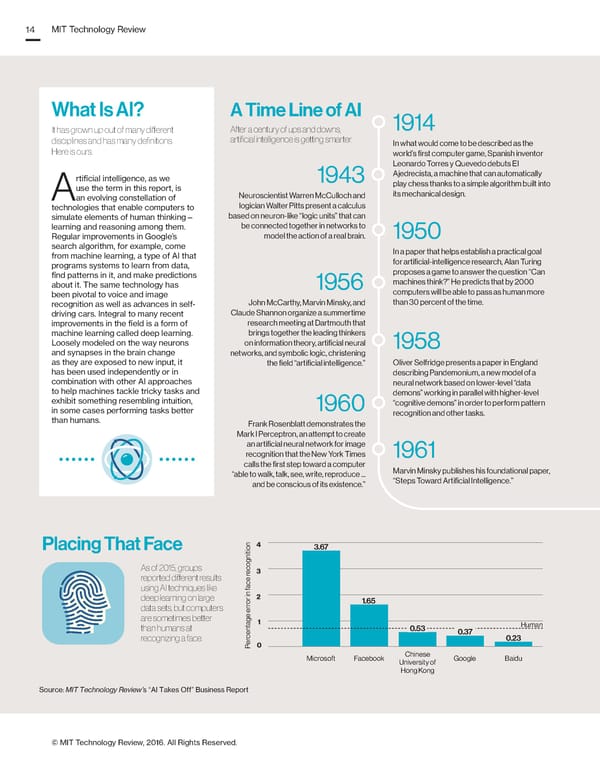MIT Technology Review 14 What Is AI? A Time Line of AI 1914 It has grown up out of many different After a century of ups and downs, disciplines and has many definitions. artificial intelligence is getting smarter. In what would come to be described as the Here is ours. world’s first computer game, Spanish inventor Leonardo Torres y Quevedo debuts El rtificial intelligence, as we 1943 Ajedrecista, a machine that can automatically use the term in this report, is play chess thanks to a simple algorithm built into Aan evolving constellation of Neuroscientist Warren McCulloch and its mechanical design. technologies that enable computers to logician Walter Pitts present a calculus simulate elements of human thinking— based on neuron-like “logic units” that can learning and reasoning among them. be connected together in networks to Regular improvements in Google’s model the action of a real brain. 1950 search algorithm, for example, come In a paper that helps establish a practical goal from machine learning, a type of AI that for artificial-intelligence research, Alan Turing programs systems to learn from data, proposes a game to answer the question “Can find patterns in it, and make predictions machines think?” He predicts that by 2000 about it. The same technology has 1956 been pivotal to voice and image computers will be able to pass as human more recognition as well as advances in self- John McCarthy, Marvin Minsky, and than 30 percent of the time. driving cars. Integral to many recent Claude Shannon organize a summertime improvements in the field is a form of research meeting at Dartmouth that machine learning called deep learning. brings together the leading thinkers Loosely modeled on the way neurons on information theory, artificial neural 1958 and synapses in the brain change networks, and symbolic logic, christening as they are exposed to new input, it the field “artificial intelligence.” Oliver Selfridge presents a paper in England has been used independently or in describing Pandemonium, a new model of a combination with other AI approaches neural network based on lower-level “data to help machines tackle tricky tasks and demons” working in parallel with higher-level exhibit something resembling intuition, 1960 “cognitive demons” in order to perform pattern in some cases performing tasks better recognition and other tasks. than humans. Frank Rosenblatt demonstrates the Mark I Perceptron, an attempt to create an artificial neural network for image recognition that the New York Times 1961 calls the first step toward a computer Marvin Minsky publishes his foundational paper, “able to walk, talk, see, write, reproduce ... “Steps Toward Artificial Intelligence.” and be conscious of its existence.” Placing That Face 4 3.67 As of 2015, groups ecognition3 reported different results r ace using AI techniques like f deep learning on large in 2 data sets, but computers or 1.65 err are sometimes better 1 than humans at tage 0.53 Human recognizing a face. cen 0.37 0.23 er0 P Microsoft Facebook Chinese Google Baidu University of Hong Kong Source: MIT Technology Review’s “AI Takes Off” Business Report © MIT Technology Review, 2016. All Rights Reserved.
 Asia's AI Agenda Page 14 Page 16
Asia's AI Agenda Page 14 Page 16